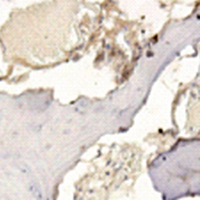Identification of abnormally high expression of POGZ as a new biomarker associated with a poor prognosis in osteosarcoma

Submitted: 17 April 2021
Accepted: 9 July 2021
Published: 3 September 2021
Accepted: 9 July 2021
Abstract Views: 1023
PDF: 549
Supplementary: 108
HTML: 14
Supplementary: 108
HTML: 14
Publisher's note
All claims expressed in this article are solely those of the authors and do not necessarily represent those of their affiliated organizations, or those of the publisher, the editors and the reviewers. Any product that may be evaluated in this article or claim that may be made by its manufacturer is not guaranteed or endorsed by the publisher.
All claims expressed in this article are solely those of the authors and do not necessarily represent those of their affiliated organizations, or those of the publisher, the editors and the reviewers. Any product that may be evaluated in this article or claim that may be made by its manufacturer is not guaranteed or endorsed by the publisher.
Similar Articles
- T. Karaca, F. Bayiroglu, M.U. Yoruk, S. Kaya, S. Uslu, B. Comba, L. Mis, Effect of royal jelly on experimental colitis Induced by acetic acid and alteration of mast cell distribution in the colon of rats , European Journal of Histochemistry: Vol. 54 No. 4 (2010)
- Qian Hu, Ran Tao, Xiaoyun Hu, Haibo Wu, Jianjun Xu, Effects of piperlonguminine on lung injury in severe acute pancreatitis via the TLR4/NF-κB pathway , European Journal of Histochemistry: Vol. 67 No. 2 (2023)
- Chunlin Ye, Bin Xu, Jie Yang, Yunkun Liu, Zhikai Zeng, Lingchun Xia, Quanjin Li, Guowen Zou, Mucin1 relieves acute lung injury by inhibiting inflammation and oxidative stress , European Journal of Histochemistry: Vol. 65 No. 4 (2021)
- C. Pellicciari, Impact of Histochemistry on biomedical research: looking through the articles published in a long-established histochemical journal , European Journal of Histochemistry: Vol. 58 No. 4 (2014)
- Liying Shen, Kongjie Lu, Zhenfeng Chen, Yingwei Zhu, Cong Zhang, Li Zhang, Pre-treatment with galectin-1 attenuates lipopolysaccharide-induced myocarditis by regulating the Nrf2 pathway , European Journal of Histochemistry: Vol. 67 No. 4 (2023)
- Yu Wang, Ziyi Wang, Wenyang Yu, Xia Sheng, Haolin Zhang, Yingying Han, Zhengrong Yuan, Qiang Weng, Seasonal expressions of androgen receptor, estrogen receptors and cytochrome P450 aromatase in the uteri of the wild Daurian ground squirrels (Spermophilus dauricus) , European Journal of Histochemistry: Vol. 62 No. 1 (2018)
- C. Fede, G. Albertin, L. Petrelli, M.M. Sfriso, C. Biz, R. De Caro, C. Stecco, Expression of the endocannabinoid receptors in human fascial tissue , European Journal of Histochemistry: Vol. 60 No. 2 (2016)
- G. Teti, V. Salvatore, A. Ruggeri, L. Manzoli, M. Gesi, G. Orsini, M. Falconi, In vitro reparative dentin: a biochemical and morphological study , European Journal of Histochemistry: Vol. 57 No. 3 (2013)
- C. Severi, R. Sferra, A. Scirocco, A. Vetuschi, N. Pallotta, A. Pronio, R. Caronna, G. Di Rocco, E. Gaudio, E. Corazziari, P. Onori, Contribution of intestinal smooth muscle to Crohn's disease fibrogenesis , European Journal of Histochemistry: Vol. 58 No. 4 (2014)
- Dajie Wang, Zhaofeng Zhou, Liang Yuan, Polydatin reverses oxidation low lipoprotein (oxLDL)-induced apoptosis of human umbilical vein endothelial cells via regulating the miR-26a-5p/BID axis , European Journal of Histochemistry: Vol. 66 No. 4 (2022)
<< < 18 19 20 21 22 23 24 25 26 27 > >>
You may also start an advanced similarity search for this article.

 https://doi.org/10.4081/ejh.2021.3264
https://doi.org/10.4081/ejh.2021.3264










